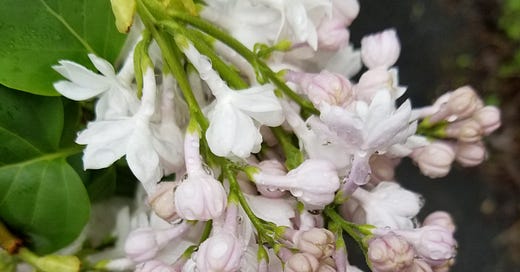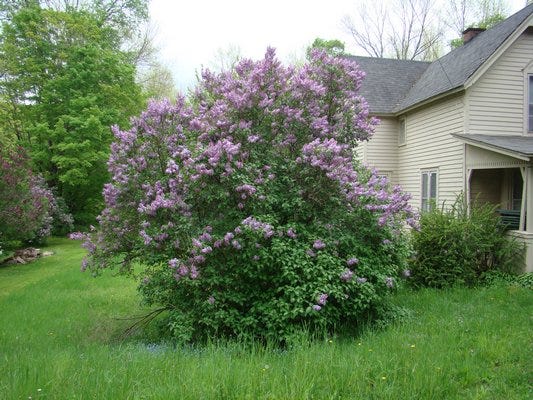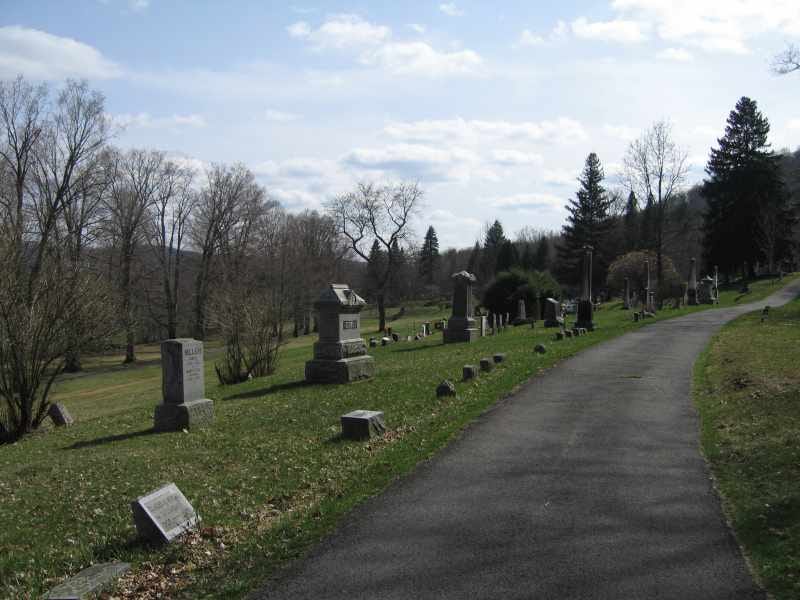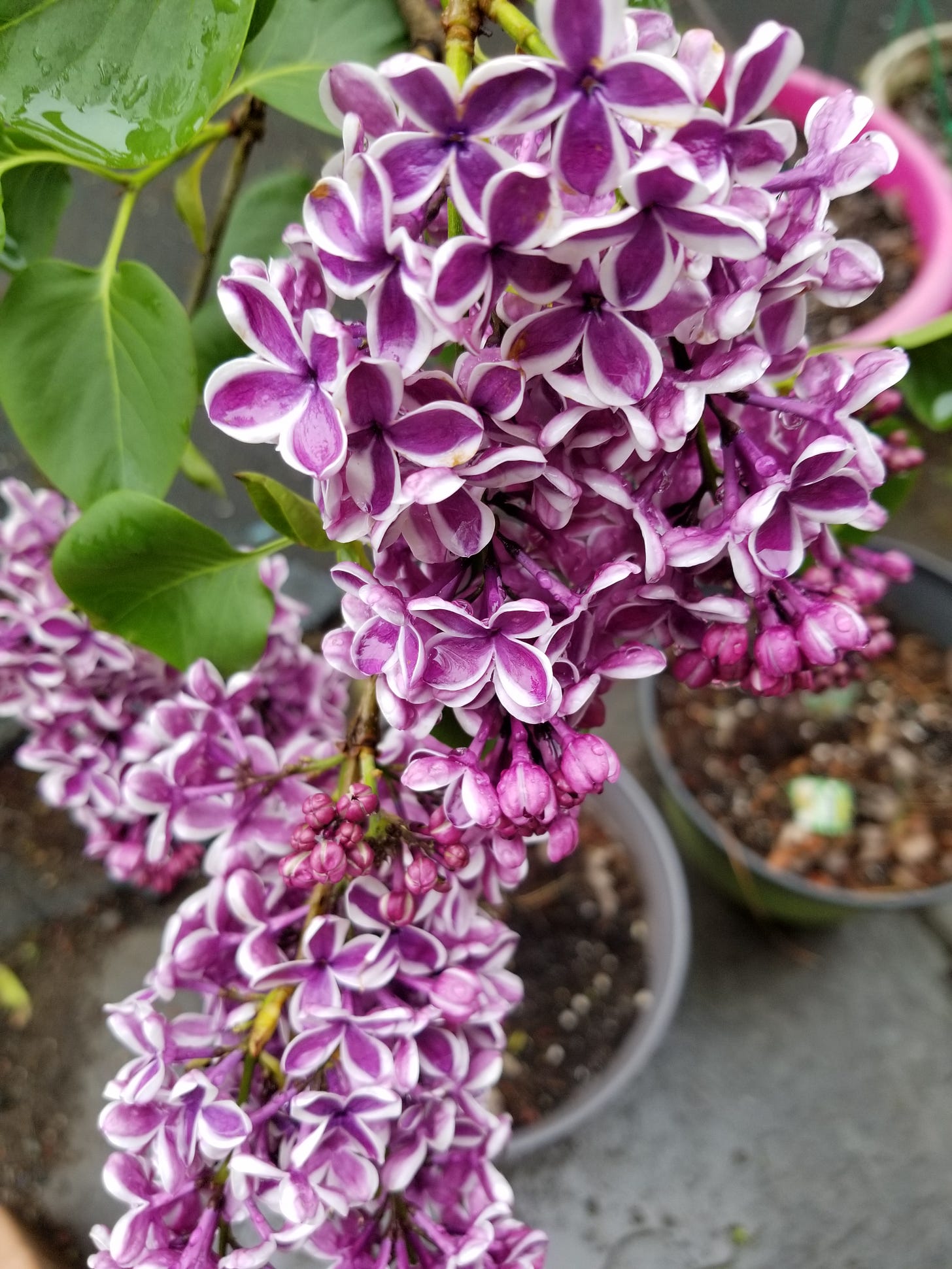(My Troy lilacs. Photo: Suzanne Spellen)
Here in upstate NY, it’s getting warmer, at least sometimes for a couple of days, and the usual and welcomed signs of spring are everywhere. My car and driveway are covered by the bud cases of the huge maple tree that hangs over the driveway from my neighbor’s yard. The pussy willows appeared and are now going to seed, and our forsythia bush is a beautiful yellow spark of color in an otherwise taupe, brown and gray asphalt covered back yard.
The grass is becoming green again in my neighbor’s yard, and songbirds are everywhere. Soon the magnolias and the fruit trees will start to blossom. We have neither, but they are all around us in the neighborhood. And then the lilacs will bloom. We have two lilac bushes in large pots in our backyard. They were planted the first spring we lived here in Troy, and although relatively small, as lilacs go, each spring we are gifted with both purpley-blue and beautiful white/pink blossoms.
Lilacs were a must even if they have to be in pots for now. They are among my favorite flowers. Lilacs, peonies and lily of the valley. We had all three on our property in Gilbertsville, and I grew up loving them all. Their scent instantly take me back to my childhood and each fragrance evokes fond memories.
We moved to Gilbertsville from Queens. Our St. Albans neighborhood was suburban in many ways, we didn’t live in a rowhouse or apartment building, but in a wood frame home built sometime in the first two decades of the 20th century. Our house was like the blocks and blocks of houses around us. We lived near a park, so it’s not like my brother and I had never seen grass or nature.
But to have so much nature all around you, there in the country! Our new home was just bursting with nature, and over the years growing up, we explored as much of it as we could. A lightly wooded area grew up to our side yard. They were new woods, as nature took over what had been cultivated or cleared land. Next to our yard, with woodland starting to hide it, was the remains of a small barn. When we moved there, it had already disintegrated to just the foundation and a partial shingled roof supported by bits of framing. We were told not to mess around in there, because of further collapse and the danger of stepping on nails, but of course we did anyway. Who can resist a ruin?
At the edge of the wood, arching into the yard was a stand of tall lilac bushes. They were probably about 10 feet tall, so we called them lilac trees. Underneath those lilacs grew a thick patch of lily of the valley plants. They are rhizomes, with a spreading root structure, so they thicky covered the entire area shaded by the lilacs. The lilacs were the familiar blue color, and the lily of the valley were white. Both had very strong fragrances. Over by the old foundation were more lilac bushes, but these were not quite as tall, and had beautiful white blossoms.
We lived almost in the center of the state, so everything had a much later start in the spring than NYC or even Troy, which is further north than Otsego county. Winter didn’t give up quickly there. But nature made up for it when spring finally arrived. The lilacs bloomed every year around the end of May. Gilbertsville and the surrounding area was settled after the Revolutionary War, and no doubt the settlers brought lilac plants with them, or purchased them later. They are not native to the state, with most of the local species originating in England and Europe.
Lilac lore from the British Isles says that lilacs are among the favorite flowers of the fairy folk. These fairies were not Tinkerbell. They were feared by many as unpredictable, often vindictive and wild. They were not pleased that humans had driven them away from their dales and valleys and into hiding. Since the fairies loved lilacs, it was thought that bringing them close to your home or in your house was to invite fairies into your home. You did not want fairies in your house. Of course, not everyone believed in angry fairies, and lilacs were popular shrubs in both country and city homes.
The Victorians were fond of lilacs for practical reasons. Before the days of embalming, which didn’t slowly begin to be practiced in the United States until after the Civil War, lilacs were popular flowers for wakes and funerals. There were no funeral homes as we know them today. Most people, from all walks of life, were laid out in a coffin at home, a service or memorial was held right there, and then they were buried.
Sometimes the body was surrounded by ice to preserve it, but that was not always possible or practical. The strong scent of lilacs, which were readily available when in season, helped to mask the odor of decay. Armfuls of lilacs were placed near the body and in the room. They were also used to mask the smells of sick rooms. For many during that time period, lilacs reminded them of death. But since death was far more accepted as an inevitable part of life, the flower and the scent remained popular.
(Photo: 27east.com)
According to most accounts, the powerful scent of lilacs was the reason why so many of them are near foundations and houses. Before indoor plumbing, most people had outhouses. The outhouse had to be close enough to get to when needed, just down the path, but far enough away so that the smell didn’t waft into the house. The privy may have been freezing to go to in the winter, but everything froze. By late spring, at lilac time, everything was melting, and I do mean everything.
Lilacs were a popular and effective way to mask the smell, just as they were used for funerals. They may have only lasted a couple of weeks, but they were effective until various spring-cleaning methods of burial and sanitization were applied. Planting lilacs near outhouses or very near homes was so pervasive that the phrase, “I’m going to smell the lilacs” was common code for the need to visit the privy.
Drive by any old house or farm out in the country in the late spring, and chances are you will see lilac bushes near the house. Often they are in the back or to the side of the house, like ours were. If you are out exploring the country side by car or hiking, you can often find old foundations or abandoned houses, and there will be lilacs there too. Old and beautiful lilacs which often have many more flowers than those that are cared for. Were they all planted to mask privies? No, many were planted long ago for their beauty, because who doesn’t love lilacs?
In exploring our property, my brother and I came upon another foundation behind our house in the woods. The foundation was almost gone, the stone probably re-purposed long ago. It had been a small structure, perhaps an out-building for a workshop, or it may well have been a cabin for servants or tenants. The woods would not have been there 100 years ago, and the building would have been visible from the main house.
(Gilbertsville lilacs. Photo: Jan Costello)
Near the foundation was the most amazing and beautiful lilac bush, about nine feet tall. The blossoms were a deep rich purple, a color I had never seen before. It was now growing thick and wild and remained invisible except for those two or three weeks when it burst into color, seen only by the birds, surrounded by the woods. Perhaps it is taken care of by the fairy folk, happy to see the absence of man.
Lilac time in Gilbertsville always came around Memorial Day, one of the town’s most important holidays. Every Memorial Day a parade was held that marched through town. The high school band played, the Girl and Boy Scouts, 4-H clubs and the Grange marched, as did the members of the fire department and the American Legion. As a World War II vet, my Dad was a member of that group.
Behind the Presbyterian church was a hill with the Dunderberg Creek running at its base. This high ground was home to the village’s Brookside Cemetery. A narrow road, not much more than a wide pathway led up to it, and every Memorial Day the entire parade, as well as many of the townspeople, made their way to the back of the church and up to the top. This was the most direct route up there. There was also a paved road that was accessed further out of town, but that would have been a much longer and harder march.
(Brookside Cemetery, Gilbertsville, NY. Photo: Aaron Skoma)
The cemetery was dedicated in 1868 and was home to many of the old founding families and their descendants, and hundreds of Gilbertsville residents from the last 150 years. Many of the residents of the cemetery were veterans, with representatives of the Civil War, both World Wars, Korea and Viet Nam interred there. Today, with little peace in the world, there are no doubt those who gave their all for their country in conflicts that occurred after my time in Gilbertsville. All the veteran graves were marked with small American flags. Flags and lilacs.
Hundreds of branches of lilacs had been brought to the cemetery by families all around town, from the village and the surrounding farms. It was a coordinated effort of some organization or church, I never knew who. Bouquets of lilacs of all colors were placed at the graves of veterans. Family members following behind the parade carried more lilacs for their loved ones, veteran or not.
As the crowd stood there, prayers for the dead were said, followed by a 21-gun salute by members of the American Legion. The acrid smell of cordite was in the air, but soon overpowered by the pervasive scent of thousands of individual lilac flowers. The ceremony ended with the poignant echo of two coronets sounding “Taps.” One player stood on the hill near the crowd, the other halfway down the road back to the village. “Day is done,” the horns announced. “All is well, safely rest, God is nigh.” The notes were carried aloft by the wind, a call to those who went before, in battle and in peace, accompanied by the wonderful smell of lilacs.
(Special thanks to my old friends Karen Swift-Shannon and Jan Costello, for answering my fact checking questions. We all made those long ago trips up the hill on Memorial Day together.)
(My Troy lilacs. Photo: Suzanne Spellen)








Lilacs always remind me of Gilbertsville. Now that I live in Virginia I buy lilac candles trying to recreate that home town feeling. We have tried planting lilacs in our yard with little success. The closest thing we have here are crepe myrtle but definitely not the same. Lilacs are synonymous with Memorial Day and taking them to the cemetery was a tradition. So many great childhood memories. Thank you again, Suzanne for the memories!
I love your lilacs! We do have quite a variety of colors around the village, and the ones I covet most are deep deep purple, near the back lawn of the Major's Inn. Lavender are ubiquitous, and white ones don't have much fragrance but add variety. We don't have a VFW here--the veteran's group is the American Legion. To most people it doesn't matter, but I guess the members know the difference, lol.